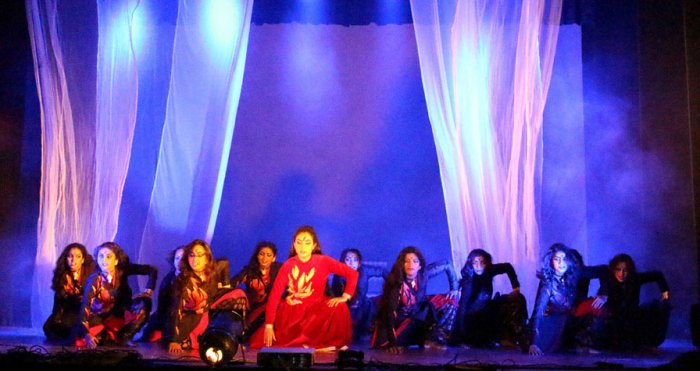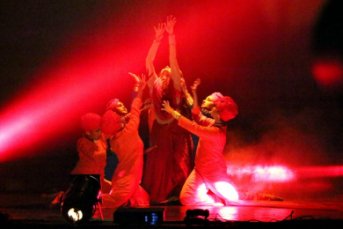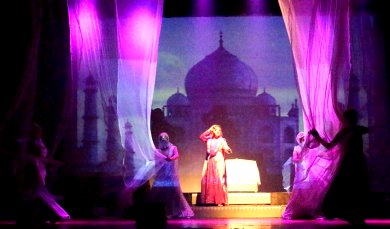
|   |

|   |
Biennial program of Nritya Kalangan and premiere of ‘Agni: The Bird of Fire’ - Nita Vidyarthi e-mail: nitavidyarthi@gmail.com Photo courtesy: Ashoke Banik July 14, 2016 Nritya Kalangan, under the guidance of dancer Jalsa Chandra, presented an evening of dance, ‘Saptavarna’- the colours of the rainbow and the premiere of a highly charged dance theatre ‘Agni:The Bird of Fire’ by the students and members of the institution at Mahajati Sadan, Kolkata. Gold medallist Jalsa Chandra, with a Nritya Praveen, was trained under Guru Thankamani Kutty in Bharatanatyam and is also proficient in Kathak. The program was conceived, choreographed and directed by Jalsa Chandra. Hence, the choreography for the evening was principally a blend of these two styles with glimpses of some contemporary dance movements.  The biennial evening began with an invocation “Sadakshara Strotam” by Sunipa Das, senior student of Chandra, followed by a colourful series of group dances ‘Saptavarna’ by students of different age groups starting from juniors. Compositions depicting white, the sun, red, orange, were comprised of pure dance (nritta) in Bharatanatyam, while yellow and indigo used the elements of Kathak. The younger students managed well in showcasing their training while the elders displayed good coordination and understanding of both the Indian classical dance styles. Their elegant costumes of a flowing skirt and a well-cut long top showed imagination. The experimental piece ‘Agni: The Bird of Fire’, conceived, choreographed and directed by Jalsa Chandra embarked with stark music, mellowing down to silence with the invocation of Agni with “Agnimiley purohitam yajnasya devam ritvijam,” the first sloka of Rig Veda. From the fire projected on the cyclorama rises the narrator Jalsa Chandra executing slow to fast chakkars recollecting the poignant episodes of different women from history through the ages. The lines “Hey aagun tumi shuddha howo, pabitra howo, nari jemon” (O, Fire, be pure and chaste, like a woman) were heart wrenching. The amplitude of concerns unleashed an explosive and relentless onslaught of movements-chakkars as Jalsa with the thump of her foot declares emphatically, “Ami sei nari-Padmini” (I am that woman - Padmini!). The play of light and shade highlights the invaders Allauddin Khilji together with shadow effects. The climax is reached with a soul-stirring, repetitive beating of the drums and the flame coloured light on the dancers.  The flame of the burning pyre on the screen behind supports the performance of the dancers on stage. The Rajput women led by their queen Padmini praying to Mahakaal and Agni to protect their dignity and finally jump fearlessly into the greatest “Chittah” (pyre). Thus through ‘Johar’ they defended and protected themselves, mercilessly. The energetic dance of the invaders in black were well synchronised with the vigour of the music. A hair-raising scene was where Jalsa as Padmini displayed her abhinaya skills through an intense and desperate expression of involvement. The audience took a while to breathe and then clapped! A showcase of good dancing, emotions, movements, sparkling energy, fine acting power, metaphor and poignant stories and finally the voices of protest of women through the ages were garlanded through skilful choreography and multimedia performance. From Agni rises ‘Yajnaseni’ who was humiliated by the Kauravas. Sunipa Das as Panchali could have had a larger share of dancing. But the game of dice was imaginatively choreographed. The dice board (Chaupar) was laid by a line of dancers moving cross-wise carrying lengths of colourful cloths with slow yet masculine movements. The fall of the dice was projected on the screen and these dancers moved as pawns. Once again Jalsa proves her ability to display her idea.  Yajnaseni rising from fire  Mumtaz Mahal The tragic episodes of Mumtaz Mahal, Sita and finally Roop Kanwar (1989) of Rajasthan (all enacted by Jalsa) were poignant parallels featured with the final protest drawing on Malala, an example where the union of video projection, pulsating movements and metallic sound bring an end to the portrayal of relentless onslaught of torture on women and the final protest and revolt. An interesting musical interlude of Tagore’s “Amar mukti aloyey aloyey ei Aakaskashey” before the sati of Roop Kanwar speak volumes about the emancipation and empowerment of women. Jalsa Chandra has put in a lot of hard work, empathy and her sensibility in evoking an intense and burning social issue through exploration of good dancing and drama. This ambitious project needs more presentations in order to generate public awareness. But, some attention to include more of dance in the piece is recommended. The Mumtaz episode had hardly any. Considering Jalsa to be a fine Bharatanatyam dancer, some solo Bharatanatyam movements by her would have been appreciated. The present trend of pumping excess of smoke and the projection of too much multi-coloured lights in performances often drown the movements of the dancers. A control on red and blue light projection could have rendered the well conceived movements more visible for this otherwise meaningful and intense piece of work. A special mention for Ratan Das for the impactful script, Dishari Chakravarty for music, Poulomi Chakravarty for the distinct and articulate narration, Ashoke and Satyajit Adhikari for the lights, Dharmendra Singh Katha for Vedic Mantra scripting and Jalsa Chandra for taking care of the costumes. Dr. Nita Vidyarthi is a veteran critic of performing arts and writes on dance, music and theatre in leading publications. |